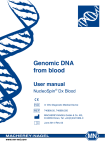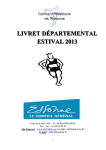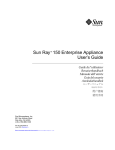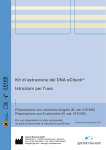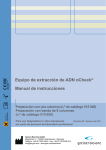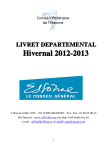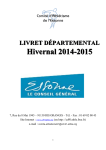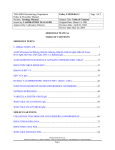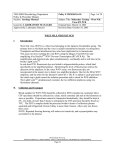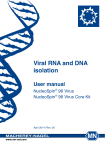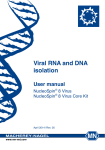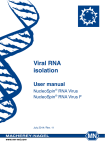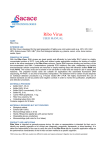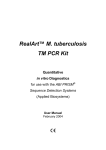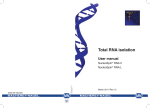Download NucleoSpin® Dx Virus - MACHEREY
Transcript
Viral nucleic acid isolation User manual NucleoSpin® Dx Virus IVD In-Vitro Diagnostic Medical Device REF 740895.50 MACHEREY-NAGEL GmbH & Co. KG, D-52355 Düren, Tel: +49 (0) 2421 969 - 0 i July 2014 / Rev. 04 Viral nucleic acid isolation Table of contents 1 Components 4 1.1 Kit contents 4 1.2 Reagents, consumables, and equipment to be supplied by user 6 1.3 About this user manual 6 2 Product description 7 2.1 Intended use 7 2.2 Product use limitations 7 2.3 Quality control 8 2.4 Introduction and kit specifications 8 2.5 Remarks regarding sample quality and preparation 10 2.6 Remarks regarding elution 10 3 Storage conditions and preparation of working solutions 11 4 Safety instructions 13 5 Viral nucleic acid purification with NucleoSpin® Dx Virus 16 5.1Protocol-at-a-glance 17 5.2 Viral RNA isolation procedure 19 5.3 Viral DNA isolation procedure 21 5.4 Simultaneous viral RNA and DNA isolation procedure 23 6Appendix 25 6.1Troubleshooting 25 6.2 Ordering information 26 6.3 Product use restriction / warranty 27 MACHEREY-NAGEL – 07 / 2014, Rev. 04 3 Viral nucleic acid isolation 1 Components 1.1 Kit contents NucleoSpin® Dx Virus 50 preps REF Symbol 740895.50 Lysis Buffer RAV1 BUF RAV1 35 mL Wash Buffer RAW BUF RAW 30 mL Wash Buffer RAV3 (Concentrate)* BUF RAV3 Conc. 12 mL RNase-free H2O H 2O Elution Buffer RE** BUF RE 13 mL Carrier RNA (lyophilized) Carrier RNA 1 mg Proteinase Buffer PB BUF PB 1.8 mL Proteinase K (lyophilized)* Proteinase K 30 mg NucleoSpin® Dx Virus Columns (dark blue rings plus Collection Tubes) 13 mL Dx Virus Columns 50 Collection Tubes (2 mL) Collection Tubes 4 x 50 Lysis Tubes (1.5 mL) Lysis Tubes 50 Elution Tubes (1.5 mL) Elution Tubes 50 User manual i * For preparation of working solutions and storage conditions see section 3. **Composition of Elution Buffer RE: 5 mM Tris/HCl, pH 8.5 4 MACHEREY-NAGEL – 07 / 2014, Rev. 04 1 Viral nucleic acid isolation LOT ➁\ REF IVD i EN Do not reuse Use by Batch Item identifica- number tion Contains sufficient for <n> tests Manufacturer In vitro diagnostic products Please read instructions for use! DE Permitted storagetemperature range Nicht wiederverwenden Verwendbar bis Chargencode Artikelnummer Ausreichend für <n> Prüfungen Hersteller In-vitroDiagnostikum Temperaturbegrenzung ES Gebrauchsanweisung beachten Producto de un solo uso Fecha de caducidad Código de lote Referencia Fabricante Diagnóstico in vitro IT Contenido suficiente para <n> tests ObsérLímites vense las de teminstrucperatura ciones de uso Non riutilizzare Utilizzare entro Codice del lotto Numero di catalogo Contenuto sufficiente per <n> test Fabbricante Consultare le istruzioni per l’uso Limiti di temperatura FR Dispositivo medicodiagnostico in vitro Ne pas réutiliser À utiliser avant Numéro de lot Référence Contenu suffisant pour “n” tests Fabricant Diagnostic in vitro Limites de température NL Respecter les instructions d’utilisation Niet hergebruiken Te gebruiken tot Productienummer Artikelnummer Fabrikant In-vitro Lees de diagnosti- bijsluiter cum DA Voldoende voor <n> tests Temperatuur begrenzing Må ikke bruges igen Holdbar til Batch kode Artikelnummer Producent EL Προϊόν μιας χρήσης Ημερομηνία λήξης Αρ. παρτίδας Αρ. είδους Tilsttrækkeli gt til <n< kontroller Επαρκεί για <n> δοκιμές Κατασκευαστής in-vitroFølg diagnosti- brugskum anvisni ngen Διαγνωστικό in vitro PL Τηρείτε τις οδηγίες χρήσης Temperaturbegrænsning Nie Przydatużywać no ść do ponownie użycia Numer partii Numer artykułu Producent Diagnosty ka in-vitro Przestrzeg ać instrukcję użycia Ogranicze nie temperatur y PT Wystarcza jąco dla kontroli <n> Não reutilizar Número de lote Número de artigo Suficiente Fabripara <n> cante testes Diagnóstico in vitro Limites de temperatura SV Observar as instruções de uso Återanvä- Använd nd ej för Lot nummer Katalognummer Räcker till Tillver„n“ antal kare tester Medicintekniska produkter för in vitro diagnostik Se handhavandebeskrivningen Temperaturbegränsning Data de vencime MACHEREY-NAGEL – 07 / 2014, Rev. 04 Όρια θερμοκρασί ας 5 Viral nucleic acid isolation EN DE ES IT FR NL DA EL PT SV Irritant Harmful Flammable Reizend Gesundheitsschädlich Entzündbar Irritante Nocivo Inflamable Irritant Nocivo Infiammabile Irritante Nocif Inflammable Irritierend Schadelijk Ontvlambaar Lokalirriterende Skadelig Brandfarlig Διaßρω-tικό Επιβλαβής Εύφλεκτα Irritante Nocivo Inflamável Irritanderende Skadligt Brandfarliga 1.2 Reagents, consumables, and equipment to be supplied by user Reagents • 96–100 % ethanol (to adjust nucleic acid binding conditions and to prepare Wash Buffer RAV3) Consumables • Disposable pipet tips (aerosol barrier pipet tips are recommended to avoid cross-contamination) Equipment • Manual pipettors • Vortex mixer • • • Centrifuge for microcentrifuge tubes Heating block or water bath for 70 °C incubation Personal protection equipment (e.g., lab coat, gloves, goggles) 1.3 About this user manual It is strongly recommended to read the detailed protocol section of this user manual. The Protocol-at-a-glance is designed to be used only as a supplemental tool for quick referencing while performing the purification procedure. MACHEREY-NAGEL user manuals are available on the internet at www.mn-net.com. 6 MACHEREY-NAGEL – 07 / 2014, Rev. 04 Viral nucleic acid isolation 2 Product description 2.1 Intended use The NucleoSpin® Dx Virus kit is a generic system for the isolation and purification of viral nucleic acids from human serum or plasma samples for subsequent in-vitro diagnostic purposes. The kit can be used with fresh and frozen human serum and plasma, stabilized with either EDTA or citrate from common blood collection systems. The kit is designed to be used with any downstream application employing enzymatic amplification and detection of RNA and DNA (e.g., RT-PCR, PCR). The viral nucleic acids isolated and purified with NucleoSpin® Dx Virus can be used in qualitative applications (e.g., RT-PCR or PCR for blood screening) as well as in quantitative applications (e.g., detection of viral load by qPCR) employing diagnostic nucleic acid amplification techniques. Any diagnostic results generated using nucleic acids isolated with the NucleoSpin® Dx Virus kit in conjunction with an in-vitro diagnostic assay should be interpreted with regard to additional clinical or laboratory findings. To minimize irregularities in diagnostic results, suitable controls for downstream applications (e.g., extraction controls, positive / negative controls) should be used. The NucleoSpin® Dx Virus kit is intended for use by professional users such as technicians and physicians experienced and trained in molecular biological techniques including experience with serum and plasma samples and viral nucleic acid isolation. The NucleoSpin® Dx Virus kit does not provide a diagnostic result. It is the sole responsibility of the user to use and validate the kit in conjunction with a downstream in-vitro diagnostic assay. Besides human samples also fresh and frozen animal samples can readily be used together with the NucleoSpin® Dx Virus kit. Samples include, but are not limited to, serum, plasma, or swabs. It has to be noted that CE IVD labeling of the kit does not apply for animal samples but is limited to human diagnostic use only. 2.2 Product use limitations The NucleoSpin® Dx Virus kit is not for use with human whole blood, tissue, stool samples, or cultured cells. The kit performance has not been evaluated with other cell-free fluid samples like urine or cerebrospinal fluid. The kit is also neither specified for the isolation and purification of bacterial, fungal, or parasite nucleic acids from human samples nor for the isolation of viral nucleic acids from human swab samples or other sample collections systems. MACHEREY-NAGEL – 07 / 2014, Rev. 04 7 Viral nucleic acid isolation 2.3 Quality control In accordance with MACHEREY-NAGEL´s Quality Management System, each lot of NucleoSpin® Dx Virus kit is tested against predetermined specifications to ensure consistent product quality. 2.4 Introduction and kit specifications NucleoSpin® Dx Virus is based on well-established NucleoSpin® silica-membrane technology and provides an easy way to isolate viral RNA and viral DNA simultaneously from 150 μL of serum or plasma samples. Purified RNA and DNA are ready-to-use for downstream amplifications like RT-PCR or PCR. The NucleoSpin® Dx Virus procedure is based on a series of simple steps: First, the serum or plasma samples are lysed in the presence of chaotropic salts. For the purification of viral DNA, Proteinase K is added to the lysis reaction. Lysis buffer and ethanol create appropriate conditions for binding of nucleic acids to the silica membrane of the NucleoSpin® Dx Virus Columns. Carrier RNA improves binding and recovery of low-concentrated viral RNA and DNA. Contaminations (potential PCR inhibitors) like salts, metabolites, and soluble macromolecular cellular components are removed in washing steps with ethanolic buffers RAW and RAV3. The nucleic acids are finally eluted in 50 μL low salt buffer or water. The linear range of the NucleoSpin® Dx Virus procedure has been determined for HCV RNA and HBV DNA in downstream diagnostic assays (Figures 1 and 2). The kit shows linearity over several orders of magnitude, comprising relevant viral titer for diagnostic purposes. 1000000 2 R = 0.996 HBV IU/mL 100000 10000 1000 HBV IU/ml 100 10 1 0.0001 0.001 0.01 0. 1 1 Sample (10fold dilution) Figure 1: Serial dilution of a plasma sample with high HBV viral load. 8 Real-time PCR of HBV DNA: Artus RealArt HBV DNA, quantification in Roche LightCycler® 480. MACHEREY-NAGEL – 07 / 2014, Rev. 04 Viral nucleic acid isolation 100000 2 R = 0.9917 HCV IU/mL 10000 1000 100 HCV IU/ml 10 1 0.001 0.01 0.1 1 Sample (10fold dilution) Figure 2: Serial dilution of a plasma sample with high HCV viral load. Real-time RT-PCR of HCV RNA: Artus RealArt HCV RNA, quantification in Roche LightCycler® 480. Kit specifications • NucleoSpin® Dx Virus is designed for the rapid preparation of highly pure viral RNA and DNA (e.g., HCV, HIV, HBV, CMV, H1N1) from plasma and serum. • NucleoSpin® Dx Virus is suitable for 150 μL serum or plasma samples. • The viral nucleic acids isolated and purified with NucleoSpin® Dx Virus can be used in qualitative applications (e.g., RT-PCR or PCR for blood screening) as well as in quantitative applications (e.g., detection of viral load by qPCR) employing diagnostic nucleic acid amplification techniques. • Protocols for isolation of viral RNA, viral DNA, and simultaneous isolation of viral RNA and DNA are included in the user manual. • The prepared nucleic acids are suitable for applications like automated fluorescent DNA sequencing, RT-PCR, or any kind of enzymatic reaction. The detection limit for certain viruses depends on the individual procedures (e.g., in-house nested (RT-) PCR). To minimize irregularities in diagnostic results, suitable controls for downstream applications (e.g., extraction controls, positive / negative controls) should be used to monitor the purification, amplification, and detection process. • Besides human samples also fresh and frozen animal samples can readily be used together with the NucleoSpin® Dx Virus kit. Samples include, but are not limited to, serum, plasma, or swabs. It has to be noted that CE IVD labeling of the kit does not apply for animal samples but is limited to human diagnostic use only. MACHEREY-NAGEL – 07 / 2014, Rev. 04 9 Viral nucleic acid isolation Table 1: Kit specifications at a glance Parameter NucleoSpin® Dx Virus Technology Silica-membrane technology Sample material Serum or plasma Sample volume 150 μL Elution volume 50 μL Preparation time Processing 30 min / 4–6 preps Centrifugation 2.5 Remarks regarding sample quality and preparation • NucleoSpin® Dx Virus is suitable for human serum or plasma samples. For successful nucleic acid purification, it is important to obtain a homogeneous, clear, and non-viscous sample lysate before adjusting binding conditions and loading the sample onto the NucleoSpin® Dx Virus Column. Check all samples (especially old or frozen samples) for precipitates. • It is very important to avoid clearing samples by centrifugation / filtration before the RAV1-lysis step, because viruses may be associated with particles or aggregates. Incubation with Buffer RAV1 can be prolonged to dissolve and digest residual cell structures, precipitates and virus particles. However, RNA is sensitive and prolonged incubation may cause decreased yields. 2.6 Remarks regarding elution 10 • Pure nucleic acids are finally eluted under low ionic strength conditions with RNase-free H2O (pH about 7–8) or slightly alkaline Buffer RE (5 mM Tris-HCl, pH 8.5), both are supplied with NucleoSpin® Dx Virus. • RNA should be eluted with the RNase-free H2O and DNA with Elution Buffer RE. • To elute both types of nucleic acids together, use RNase-free H2O provided with the kit, preheated to 70 °C. MACHEREY-NAGEL – 07 / 2014, Rev. 04 Viral nucleic acid isolation 3 Storage conditions and preparation of working solutions Attention: Buffer RAV1 contains guanidinium thiocyanate and Buffer RAW contains guanidine hydrochloride which can form highly reactive compounds when combined with bleach (sodium hypochlorite). DO NOT add bleach or acidic solutions directly to the sample-preparation waste. • Check all components for damages after receiving the kit. If kit contents like buffer bottles or blister packages are damaged, contact MACHEREY-NAGEL technical support and customer service, or your local distributor. • Do not use damaged kit components. • Upon arrival the NucleoSpin® Dx Virus kit should be stored at room temperature (18–25 °C). It is NOT required to open the kit on delivery and remove individual components for separate storage. • NucleoSpin® Dx Virus Columns can be used until the expiration date on the kit box. • Use RNase-free equipment. Before starting the NucleoSpin® Dx Virus protocol prepare the following: • Lyophilized Proteinase K can be stored at room temperature (18–25 °C) until the expiration date without decrease in performance. Before first use of the kit, add the indicated volume of Proteinase Buffer PB to dissolve lyophilized Proteinase K. Reconstituted Proteinase K should be stored at -20 °C for up to 6 months, but only until the expiration date. • Carrier RNA: Before first use, add 1 mL Lysis Buffer RAV1 to the Carrier RNA vial. Dissolve the Carrier RNA and pipette the solution back to the RAV1 bottle. Note: Due to the production procedure and the small amount of Carrier RNA contained in the vial, the Carrier RNA may hardly be visible. Lysis Buffer RAV1 including Carrier RNA can be stored at 4 °C for up to 4 weeks. Storage at 4 °C or below may cause salt precipitation. If precipitates are visible, make sure to dissolve all precipitates before use by heating at 40–60 °C for a maximum of 5 min. Carrier RNA dissolved in Buffer RAV1 and stored at -20 °C is stable for at least one year. Do not warm up Buffer RAV1 containing Carrier RNA more than 4 times! Frequent warming, temperatures > 80 °C, and extended heat incubation will accelerate the degradation of Carrier RNA. MACHEREY-NAGEL – 07 / 2014, Rev. 04 11 Viral nucleic acid isolation • Wash Buffer RAV3: Add the indicated volume (see table below or on the bottle) of ethanol (96–100 %) to Wash Buffer RAV3 Concentrate. Mark the label of the bottle to indicate that the ethanol is added. Store Wash Buffer RAV3 at room temperature. Wash Buffer RAV3 can be stored at room temperature (18–25 °C) for up to one year but only until the expiration date. NucleoSpin® Dx Virus 50 preps REF 740895.50 Wash Buffer RAV3 (Concentrate) Proteinase K 12 12 mL Add 48 mL ethanol 30 mg Add 1.35 mL Proteinase Buffer PB MACHEREY-NAGEL – 07 / 2014, Rev. 04 Viral nucleic acid isolation 4 Safety instructions The following components of the NucleoSpin® Dx Virus kits contain hazardous contents. Wear gloves and goggles and follow the safety instructions given in this section. GHS classification Only harmful features do not need to be labeled with H and P phrases up to 125 mL or 125 g. Mindergefährliche Eigenschaften müssen bis 125 mL oder 125 g nicht mit H- und P-Sätzen gekennzeichnet werden. Component Hazard contents GHS symbol Hazard Precaution phrases phrases Inhalt Gefahrstoff GHS Symbol H-Sätze P-Sätze RAV1 Guanidinium thiocyanate 30–60 % Warning Guanidiniumthiocyanat 30–60 % Achtung 302, 412, EUH031 260, 273, 301+312, 330 Guanidine hydrochloride 24–36 % + ethanol 3555 % Warning 226, 302 210, 233, 301+312, 330, 403+235 Guanidinhydrochlorid 24–36 % + Ethanol 35–55 % Achtung Proteinase K, lyophilized Danger 315, 317, 319, 334, 335 261, 280, 302+352, 304+340, 305+351+338, 312, 332+313, 337+313, 342+311, 363, 403+233 RAW Proteinase K Proteinase K, lyophilisiert Gefahr Hazard phrases H 226 Flammable liquid and vapour. H 302 Harmful if swallowed. H 315 Causes skin irritation. H 317 May cause an allergic skin reaction. H 319 Causes serious eye irritation. H 334 May cause allergy or asthma symptoms or breathing difficulties if inhaled. H 335 May cause respiratory irritation. H 412 Harmful to aquatic life with long lasting effects. Flüssigkeit und Dampf entzündbar. Gesundheitsschädlich bei Verschlucken. Verursacht Hautreizungen. Kann allergische Hautreaktionen verursachen. Verursacht schwere Augenreizung. Kann bei Einatmen Allergie, asthmaartige Symptome oder Atembeschwerden verursachen. Kann die Atemwege reizen. Schädlich für Wasserorganismen, mit langfristiger Wirkung. MACHEREY-NAGEL – 07 / 2014, Rev. 04 13 Viral nucleic acid isolation EUH031 Contact with acids liberates toxic gas. Entwickelt bei Berührung mit Säure giftige Gase. Precaution phrases P 210 Keep away from heat, hot surfaces, sparks, open flames and other ignition sources. No smoking. Von Hitze, heißen Oberflächen, Funken, offenen Flammen sowie anderen Zündquellenarten fernhalten. Nicht rauchen. P 233 Keep container tightly closed P 260 Do not breathe vapours. P 261 Avoid breathing dust. P 273 Avoid release to the environment. P 280 Wear protective gloves / eye protection. P 301+312 IF SWALLOWED: Call a POISON CENTER/ doctor/…/if you feel unwell. P 302+352 IF ON SKIN: Wash with plenty of water/… P 304+340 IF INHALED: Remove victim to fresh air and keep at rest in a position comfortable for breathing. Behälter dicht verschlossen halten. Dampf nicht einatmen. Einatmen von Staub vermeiden. Freisetzung in die Umwelt vermeiden. Schutzhandschuhe / Augenschutz tragen. BEI VERSCHLUCKEN: Bei Unwohlsein GIFTINFORMATIONSZENTRUM / Arzt /… anrufen. BEI KONTAKT MIT DER HAUT: Mit viel Wasser/… waschen. BEI EINATMEN: An die frische Luft bringen und in einer Position ruhigstellen, die das Atmen erleichtert. P 305+351+338 IF IN EYES: Rinse continuously with water for several minutes. Remove contact lenses if present and easy to do – continue rinsing. BEI KONTAKT MIT DEN AUGEN: Einige Minuten lang behutsam mit Wasser spülen. Vorhandene Kontaktlinsen nach Möglichkeit entfernen. Weiter spülen. P 312 Call a POISON CENTER/ doctor/…/if you feel unwell. P 330 Rinse mouth. P 332+313 If skin irritation occurs: Get medical advice / attention. P 337+313 Get medical advice / attention. P 342+311 If experiencing respiratory symptoms: Call a POISON CENTER/ doctor/… P 363 Wash contaminated clothing before reuse. P 403+233 Store in a well ventilated place. Keep container tightly closed. P 403+235 Store in a well ventilated place. Keep cool. Bei Unwohlsein GIFTINFORMATIONSZENTRUM / Arzt /… anrufen. Mund ausspülen. Bei Hautreizung: Ärztlichen Rat einholen / ärztliche Hilfe hinzuziehen. Bei anhaltende Augenreizung: Ärztlichen Rat einholen / ärztliche Hilfe hinzuziehen. Bei Symptomen der Atemwege: GIFTINFORMATIONSZENTRUM /Arzt/… anrufen. Kontaminierte Kleidung vor erneutem Tragen waschen. Behälter dicht verschlossen an einem gut belüfteten Ort aufbewahren. Kühl an einem gut belüfteten Ort aufbewahren. For further information please see Material Safety Data Sheets (www.mn-net.com). Weiterführende Informationen finden Sie in den Sicherheitsdatenblättern (www.mn-net.com). 14 MACHEREY-NAGEL – 07 / 2014, Rev. 04 Viral nucleic acid isolation When working with the NucleoSpin® Dx Virus kit wear suitable protective clothing (e.g., lab coat, disposable gloves, and protective goggles). For more information consult the appropriate Material Safety Data Sheets (MSDS available online at http://www.mn-net.com/msds). Caution: Guanidinium thiocyanate in Lysis Buffer RAV1 and guanidine hydrochloride in Wash Buffer RAW can form highly reactive compounds when combined with bleach! Thus, do not add bleach or acidic solutions directly to the sample preparation waste. The waste generated with the NucleoSpin® Dx Virus kit has not been tested for residual infectious material. A contamination of the liquid waste with residual infectious material is highly unlikely due to strong denaturing lysis buffer and Proteinase K treatment but it cannot be excluded completely. Therefore, liquid waste must be considered infectious and should be handled and discarded according local safety regulations. MACHEREY-NAGEL – 07 / 2014, Rev. 04 15 NucleoSpin® Dx Virus 5 Viral nucleic acid purification with NucleoSpin® Dx Virus The procedures below provide instructions for processing a single plasma or serum sample. However, several samples can be processed at the same time; the number depends on the capacity of the microcentrifuge used. Before starting the preparation: 16 • Check that Wash Buffer RAV3 and Proteinase K were prepared according to section 3. • Check that Carrier RNA has been dissolved in Lysis Buffer RAV1 according to section 3. • Check that 96–100 % ethanol (denatured or non-denatured) is available to adjust nucleic acid binding conditions. • Set an incubator (e.g., heating block) or water bath to 70 °C. • Equilibrate the plasma/serum samples to room temperature (18–25 °C). Make sure that the samples are mixed well. • If a precipitate has formed in Lysis Buffer RAV1 or Buffer RAW, incubate the buffer at 40–60 °C until the precipitate is dissolved. • Generally, do not mix reagents and columns from different kits and lots. • Heat RNase-free H2O / Elution Buffer RE to 70 °C for final elution of nucleic acids. • Do not add Proteinase K solution directly to Lysis Buffer RAV1. The sample has to be combined with the Lysis Buffer RAV1 before addition of Proteinase K. • All centrifugation steps should be carried out at room temperature (18–25 °C). MACHEREY-NAGEL – 07 / 2014, Rev. 04 NucleoSpin® Dx Virus 5.1 Protocol-at-a-glance Supplemental protocol-overview: Carefully read the detailed protocol (section 5.2–5.4) before starting the procedure. Note: The protocols differ in Proteinase K lysis step (step 3) and elution step (step 24) only. Provide sample, lyse viruses, clear lysate Viral RNA isolation procedure (section 5.2) Viral DNA isolation procedure (section 5.3) Viral RNA + DNA isolation procedure (section 5.4) 1 150 μL sample in Lysis Tubes 150 μL sample in Lysis Tubes 150 μL sample in Lysis Tubes 2 600 μL Buffer RAV1 containing Carrier RNA 600 μL Buffer RAV1 containing Carrier RNA 600 μL Buffer RAV1 containing Carrier RNA 3 Note: 20 μL Proteinase K 20 μL Proteinase K No Proteinase K is (Incubate at least (Incubate at least used for the isolation 1 min at room 1 min at room of viral RNA only temperature) temperature) 4 Pipette mixture up and down and vortex well Pipette mixture up and down and vortex well Pipette mixture up and down and vortex well 5 Incubate at 70 °C for 5 min Incubate at 70 °C for 5 min Incubate at 70 °C for 5 min 6 Short spin to clean the lid Short spin to clean the lid Short spin to clean the lid Adjust binding conditions 7 600 μL ethanol 600 μL ethanol 600 μL ethanol 8 Mix by vortexing (10–15 s) Mix by vortexing (10–15 s) Mix by vortexing (10–15 s) Bind RNA/ DNA 9 Load 700 μL lysate onto the NucleoSpin® Dx Virus Column Load 700 μL lysate onto the NucleoSpin® Dx Virus Column Load 700 μL lysate onto the NucleoSpin® Dx Virus Column 10 8,000 x g, 1 min 8,000 x g, 1 min 8,000 x g, 1 min MACHEREY-NAGEL – 07 / 2014, Rev. 04 17 NucleoSpin® Dx Virus 11 Transfer the NucleoSpin® Dx Virus Column to a new Collection Tube Load the residual lysate (ca. 650 μL) onto the column Transfer the NucleoSpin® Dx Virus Column to a new Collection Tube Load the residual lysate (ca. 650 μL) onto the column Transfer the NucleoSpin® Dx Virus Column to a new Collection Tube Load the residual lysate (ca. 650 μL) onto the column 13 8,000 x g, 1 min 8,000 x g, 1 min 8,000 x g, 1 min 14 Transfer the NucleoSpin® Dx Virus Column to a new Collection Tube Transfer the NucleoSpin® Dx Virus Column to a new Collection Tube Transfer the NucleoSpin® Dx Virus Column to a new Collection Tube 15 500 μL RAW 500 μL RAW 500 μL RAW 16 8,000 x g, 1 min 8,000 x g, 1 min 8,000 x g, 1 min 17 Transfer the NucleoSpin® Dx Virus Column to a new Collection Tube Transfer the NucleoSpin® Dx Virus Column to a new Collection Tube Transfer the NucleoSpin® Dx Virus Column to a new Collection Tube 18 600 μL RAV3 600 μL RAV3 600 μL RAV3 19 8,000 x g, 1 min 8,000 x g, 1 min 8,000 x g, 1 min 20 Transfer the NucleoSpin® Dx Virus Column to a new Collection Tube Transfer the NucleoSpin® Dx Virus Column to a new Collection Tube Transfer the NucleoSpin® Dx Virus Column to a new Collection Tube 21 200 μL RAV3 200 μL RAV3 200 μL RAV3 22 11,000 x g, 3 min 11,000 x g, 3 min 11,000 x g, 3 min 23 Transfer the NucleoSpin® Dx Virus Column to an Elution Tube Transfer the NucleoSpin® Dx Virus Column to an Elution Tube Transfer the NucleoSpin® Dx Virus Column to an Elution Tube 24 50 μL RNase-free H2O (70 °C); Incubate 1–2 min 50 μL Buffer RE (70 °C); Incubate 1–2 min 50 μL RNasefree H2O (70 °C); Incubate 1–2 min 25 11,000 x g, 1 min 11,000 x g, 1 min 11,000 x g, 1 min 12 Wash silica membrane Elute RNA/ DNA 18 MACHEREY-NAGEL – 07 / 2014, Rev. 04 NucleoSpin® Dx Virus – viral RNA isolation procedure 5.2 Viral RNA isolation procedure 1. Provide 150 μL sample in a Lysis Tube (1.5 mL, provided). 2. Add 600 μL Buffer RAV1 containing Carrier RNA to the Lysis Tube. 3. Note: No Proteinase K is used for the isolation of viral RNA only. 4. Pipette mixture up and down and vortex well. 5. Incubate for 5 min at 70 °C. 6. Briefly centrifuge Lysis Tube (approx. 1 s at 2,000 x g) to remove drops from the lid (short spin only). 7. Add 600 μL ethanol (96–100 %) to the clear lysate. 8. Mix by vortexing (10–15 s). 9. Carefully load 700 μL of the lysate onto the NucleoSpin® Dx Virus Column placed in a Collection Tube and close the lid. 10. Centrifuge 1 min at 8,000 x g. 11. Place the NucleoSpin® Dx Virus Column into a new Collection Tube (2 mL, provided) and discard the Collection Tube with flow-through from the previous step. 12. Load the residual lysate (approx. 650 μL) onto the NucleoSpin® Dx Virus Column and close the lid. 13. Centrifuge 1 min at 8,000 x g. 14. Place the NucleoSpin® Dx Virus Column into a new Collection Tube (2 mL, provided) and discard the Collection Tube with flow-through from the previous step. 15. Add 500 μL Buffer RAW to the NucleoSpin® Dx Virus Column. 16. Centrifuge 1 min at 8,000 x g. 17. Place the NucleoSpin® Dx Virus Column into a new Collection Tube (2 mL, provided) and discard the Collection Tube with flow-through from the previous step. 18. Add 600 μL Buffer RAV3 to the NucleoSpin® Dx Virus Column. 19. Centrifuge 1 min at 8,000 x g. 20. Place the NucleoSpin® Dx Virus Column into a new Collection Tube (2 mL, provided) and discard the Collection Tube with flow-through from the previous step. MACHEREY-NAGEL – 07 / 2014, Rev. 04 19 NucleoSpin® Dx Virus – viral RNA isolation procedure 21. Add 200 μL Buffer RAV3 to the NucleoSpin® Dx Virus Column. 22. Centrifuge 3 min at 11,000 x g. 23. Place the NucleoSpin® Dx Virus Column into an Elution Tube (1.5 mL, provided) and discard the Collection Tube with flow-through from the previous step. 24. Add 50 μL RNase-free H2O (preheated to 70 °C) and incubate for 1–2 min. 25. Centrifuge 1 min at 11,000 x g to elute nucleic acid from the column. 20 MACHEREY-NAGEL – 07 / 2014, Rev. 04 NucleoSpin® Dx Virus – viral DNA isolation procedure 5.3 Viral DNA isolation procedure 1. Provide 150 μL sample in a Lysis Tube (1.5 mL, provided). 2. Add 600 μL Buffer RAV1 containing Carrier RNA to the Lysis Tube. 3. Add 20 μL Proteinase K solution to the Lysis Tube. 4. Pipette mixture up and down and vortex well. 5. Incubate for 5 min at 70 °C. 6. Briefly centrifuge Lysis Tube (approx. 1 s at 2,000 x g) to remove drops from the lid (short spin only). 7. Add 600 μL ethanol (96–100 %) to the clear lysate. 8. Mix by vortexing (10–15 s). 9. Carefully load 700 μL of the lysate onto the NucleoSpin® Dx Virus Column placed in a Collection Tube and close the lid. Note: Proteinase K is necesary for lysis of DNA viruses. Note: Make sure that the mixture incubates at least 1 min at room temperature before starting the heat incubation. 10. Centrifuge 1 min at 8,000 x g. 11. Place the NucleoSpin® Dx Virus Column into a new Collection Tube (2 mL, provided) and discard the Collection Tube with flow-through from the previous step. 12. Load the residual lysate (approx. 650 μL) onto the NucleoSpin® Dx Virus Column and close the lid. 13. Centrifuge 1 min at 8,000 x g. 14. Place the NucleoSpin® Dx Virus Column into a new Collection Tube (2 mL, provided) and discard the Collection Tube with flow-through from the previous step. 15. Add 500 μL Buffer RAW to the NucleoSpin® Dx Virus Column. 16. Centrifuge 1 min at 8,000 x g. 17. Place the NucleoSpin® Dx Virus Column into a new Collection Tube (2 mL, provided) and discard the Collection Tube with flow-through from the previous step. 18. Add 600 μL Buffer RAV3 to the NucleoSpin® Dx Virus Column. 19. Centrifuge 1 min at 8,000 x g. MACHEREY-NAGEL – 07 / 2014, Rev. 04 21 NucleoSpin® Dx Virus – viral DNA isolation procedure 20. Place the NucleoSpin® Dx Virus Column into a new Collection Tube (2 mL, provided) and discard the Collection Tube with flow-through from the previous step. 21. Add 200 μL Buffer RAV3 to the NucleoSpin® Dx Virus Column. 22. Centrifuge 3 min at 11,000 x g. 23. Place the NucleoSpin® Dx Virus Column into an Elution Tube (1.5 mL, provided) and discard the Collection Tube with flow-through from the previous step. 24. Add 50 μL Buffer RE (preheated to 70 °C) and incubate for 1–2 min. 25. Centrifuge 1 min at 11,000 x g to elute nucleic acid from the column. 22 MACHEREY-NAGEL – 07 / 2014, Rev. 04 NucleoSpin® Dx Virus – simultaneuos viral RNA and DNA isolation procedure 5.4 Simultaneous viral RNA and DNA isolation procedure 1. Provide 150 μL sample in a Lysis Tube (1.5 mL, provided). 2. Add 600 μL Buffer RAV1 containing Carrier RNA to the Lysis Tube. 3. Add 20 μL Proteinase K solution to the Lysis Tube. 4. Pipette mixture up and down and vortex well. 5. Incubate for 5 min at 70 °C. 6. Briefly centrifuge Lysis Tube (approx. 1 s at 2,000 x g) to remove drops from the lid (short spin only). 7. Add 600 μL ethanol (96–100 %) to the clear lysate. 8. Mix by vortexing (10–15 s). 9. Carefully load 700 μL of the lysate onto the NucleoSpin® Dx Virus Column placed in a Collection Tube and close the lid. Note: Proteinase K is necesary for lysis of DNA viruses. Note: Make sure that the mixture incubates at least 1 min at room temperature before starting the heat incubation. 10. Centrifuge 1 min at 8,000 x g. 11. Place the NucleoSpin® Dx Virus Column into a new Collection Tube (2 mL, provided) and discard the Collection Tube with flow-through from the previous step. 12. Load the residual lysate (approx. 650 μL) onto the NucleoSpin® Dx Virus Column and close the lid. 13. Centrifuge 1 min at 8,000 x g. 14. Place the NucleoSpin® Dx Virus Column into a new Collection Tube (2 mL, provided) and discard the Collection Tube with flow-through from the previous step. 15. Add 500 μL Buffer RAW to the NucleoSpin® Dx Virus Column. 16. Centrifuge 1 min at 8,000 x g. 17. Place the NucleoSpin® Dx Virus Column into a new Collection Tube (2 mL, provided) and discard the Collection Tube with flow-through from the previous step. 18. Add 600 μL Buffer RAV3 to the NucleoSpin® Dx Virus Column. 19. Centrifuge 1 min at 8,000 x g. MACHEREY-NAGEL – 07 / 2014, Rev. 04 23 NucleoSpin® Dx Virus – simultaneuos viral RNA and DNA isolation procedure 20. Place the NucleoSpin® Dx Virus Column into a new Collection Tube (2 mL, provided) and discard the Collection Tube with flow-through from the previous step. 21. Add 200 μL Buffer RAV3 to the NucleoSpin® Dx Virus Column. 22. Centrifuge 3 min at 11,000 x g. 23. Place the NucleoSpin® Dx Virus Column into an Elution Tube (1.5 mL, provided) and discard the Collection Tube with flow-through from the previous step. 24. Add 50 μL RNase-free H2O (preheated to 70 °C) and incubate for 1–2 min. 25. Centrifuge 1 min at 11,000 x g to elute nucleic acid from the column. 24 MACHEREY-NAGEL – 07 / 2014, Rev. 04 Viral nucleic acid isolation 6 Appendix 6.1 Troubleshooting Problem Possible cause and suggestions Low viral load in the sample • The nucleic acid yield depends on the viral load in the sample. Problems with Carrier RNA Small amounts or no viral nucleic acids in the eluate • Carrier RNA not added. • See remarks concerning storage of Buffer RAV1 with Carrier RNA (section 3). Proteinase K digestion may be necessary • Choose the appropriate protocol for viral RNA or viral DNA isolation, see section 5.1. Viral nucleic acids degraded Problems with subsequent detection • Samples should be processed immediately. Ensure appropriate storage conditions up to the processing. • Check that all buffers have been prepared and stored correctly. If in doubt, use new aliquots of Buffer RAV1, Carrier RNA and Elution Buffer RE. Reduced sensitivity • Change the volume of eluate added to the PCR / RT-PCR. Ethanol carry-over • Prolong centrifugation step (step 22) in order to remove Buffer RAV3 completely. MACHEREY-NAGEL – 07 / 2014, Rev. 04 25 Viral nucleic acid isolation 6.2 Ordering information Product REF Pack of NucleoSpin® Dx Virus 740895.50 50 NucleoSpin® Dx Blood 740899.50 / .250 50 / 250 740983.10 / .50 / .250 10 / 50 / 250 740958 25 NucleoSpin® totalRNA FFPE XS 740969.10 / .50 / .250 10 / 50 / 250 NucleoSpin® totalRNA FFPE 740982.10 / .50 / .250 10 / 50 / 250 NucleoSpin® DNA FFPE XS 740980.10 / .50 / .250 10 / 50 / 250 NucleoSpin® Blood 740951.10 / .50 / .250 10 / 50 / 250 NucleoSpin® Tissue 740952.10 / .50 / .250 10 / 50 / 250 NucleoSpin® Tissue XS 740901.10 / .50 / .250 10 / 50 / 250 NucleoSpin® miRNA 740971.10 / .50 / .250 10 / 50 / 250 Proteinase K 740506 100 mg Collection Tubes (2 mL) 740600 1000 CE-IVD marked kits Kits for research purposes NucleoSpin® Virus NucleoSpin® RNA Virus F Visit www.mn-net.com for more detailed product information. 26 MACHEREY-NAGEL – 07 / 2014, Rev. 04 Viral nucleic acid isolation 6.3 Product use restriction / warranty The NucleoSpin® Dx Virus kit is a generic system for the isolation and purification of viral nucleic acids from human plasma or serum samples for subsequent in-vitro diagnostic purposes. The kit is designed to be used with any downstream application employing enzymatic amplification and detection of RNA and DNA (e.g., RT-PCR, PCR). Any and all diagnostic results generated using nucleic acids isolated with the NucleoSpin® Dx Virus kit in conjunction with a diagnostic assay should be interpreted with regard to additional clinical or laboratory findings. The NucleoSpin® Dx Virus kit does not provide a diagnostic result. It is the sole responsibility of the user to use and validate the kit in conjunction with a downstream in-vitro diagnostic assay. ONLY MACHEREY-NAGEL products specially labeled as IVD are suitable for IN-VITRO-diagnostic use. The NucleoSpin® Dx Virus kit is intended for use by professional users such as technicians and physicians experienced and trained in molecular biological techniques including experience with serum and plasma samples and viral nucleic acid isolation. For safety instructions please refer to the respective chapter in the user manual. NucleoSpin® Dx Virus kit shall exclusively be used in an adequate test environment, i.e. a suitable laboratory setting. The respective user is liable for any and all damages resulting from application of the NucleoSpin® Dx Virus kit for use deviating from the intended use as specified in the user manual. This MACHEREY-NAGEL product is shipped with documentation stating specifications and other technical information. MACHEREY-NAGEL warrants to meet the stated specifications. MACHEREY-NAGEL´s sole obligation and the customer´s sole remedy is limited to replacement of products free of charge in the event products fail to perform as warranted. Supplementary reference is made to the general business terms and conditions of MACHEREY-NAGEL, which are printed on the price list. Please contact us if you wish to get an extra copy. There is no warranty for and MACHEREY-NAGEL is not liable for damages or defects arising in shipping and handling (transport insurance for customers excluded), or out of accident or improper or abnormal use of this product; defects in products or components not manufactured by MACHEREY-NAGEL, or damages resulting from such nonMACHEREY-NAGEL components or products. MACHEREY-NAGEL makes no other warranty of any kind whatsoever, and SPECIFICALLY DISCLAIMS AND EXCLUDES ALL OTHER WARRANTIES OF ANY KIND OR NATURE WHATSOEVER, DIRECTLY OR INDIRECTLY, EXPRESS OR IMPLIED, INCLUDING, WITHOUT LIMITATION, AS TO THE SUITABILITY, REPRODUCTIVITY, DURABILITY, FITNESS FOR A PARTICULAR PURPOSE OR USE, MERCHANTABILITY, CONDITION, OR ANY OTHER MATTER WITH RESPECT TO MACHEREY-NAGEL PRODUCTS. In no event shall MACHEREY-NAGEL be liable for claims for any other damages, whether direct, indirect, incidental, compensatory, foreseeable, consequential, or special (including but not limited to loss of use, revenue or profit), whether based upon warranty, contract, tort MACHEREY-NAGEL – 07 / 2014, Rev. 04 27 Viral nucleic acid isolation (including negligence) or strict liability arising in connection with the sale or the failure of MACHEREY-NAGEL products to perform in accordance with the stated specifications. This warranty is exclusive and MACHEREY-NAGEL makes no other warranty expressed or implied. The warranty provided herein and the data, specifications and descriptions of this MACHEREY-NAGEL product appearing in MACHEREY-NAGEL published catalogues and product literature are MACHEREY-NAGEL´s sole representations concerning the product and warranty. No other statements or representations, written or oral, by MACHEREY-NAGEL´s employees, agent or representatives, except written statements signed by a duly authorized officer of MACHEREY-NAGEL are authorized; they should not be relied upon by the customer and are not a part of the contract of sale or of this warranty. Product claims are subject to change. Therefore please contact our Technical Service Team for the most up-to-date information on MACHEREY-NAGEL products. You may also contact your local distributor for general scientific information. Applications mentioned in MACHEREY-NAGEL literature are provided for informational purposes only. MACHEREY-NAGEL does not warrant that all applications have been tested in MACHEREY-NAGEL laboratories using MACHEREY-NAGEL products. MACHEREYNAGEL does not warrant the correctness of any of those applications. Please contact: Please contact: MACHEREY-NAGEL Germany Tel.: +49 (0) 24 21 969 270 e-mail: [email protected] Last updated: 07 / 2010, Rev. 03 Trademarks: LightCycler is a registres trademark of the Roche Group NucleoSpin is a trademark of MACHEREY-NAGEL GmbH & Co KG All used names and denotations can be brands, trademarks, or registered labels of their respective owner – also if they are not special denotation. To mention products and brands is only a kind of information (i.e., it does not offend against trademarks and brands and can not be seen as a kind of recommendation or assessment). Regarding these products or services we can not grant any guarantees regarding selection, efficiency, or operation. 28 MACHEREY-NAGEL – 07 / 2014, Rev. 04




























